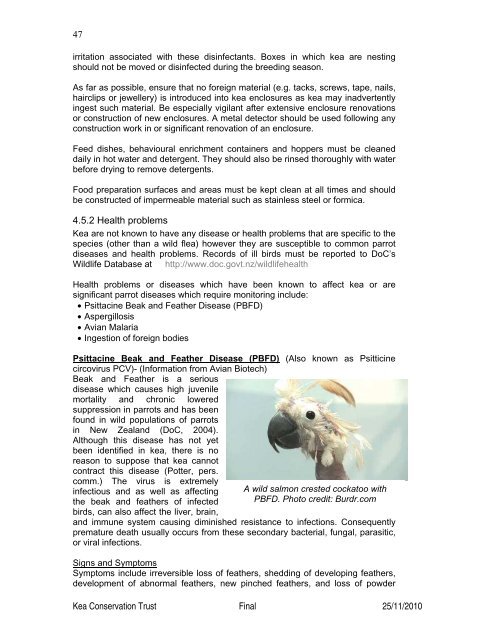(Nestor notabilis) Husbandry Manual - Kea Conservation Trust
(Nestor notabilis) Husbandry Manual - Kea Conservation Trust
(Nestor notabilis) Husbandry Manual - Kea Conservation Trust
You also want an ePaper? Increase the reach of your titles
YUMPU automatically turns print PDFs into web optimized ePapers that Google loves.
47<br />
irritation associated with these disinfectants. Boxes in which kea are nesting<br />
should not be moved or disinfected during the breeding season.<br />
As far as possible, ensure that no foreign material (e.g. tacks, screws, tape, nails,<br />
hairclips or jewellery) is introduced into kea enclosures as kea may inadvertently<br />
ingest such material. Be especially vigilant after extensive enclosure renovations<br />
or construction of new enclosures. A metal detector should be used following any<br />
construction work in or significant renovation of an enclosure.<br />
Feed dishes, behavioural enrichment containers and hoppers must be cleaned<br />
daily in hot water and detergent. They should also be rinsed thoroughly with water<br />
before drying to remove detergents.<br />
Food preparation surfaces and areas must be kept clean at all times and should<br />
be constructed of impermeable material such as stainless steel or formica.<br />
4.5.2 Health problems<br />
<strong>Kea</strong> are not known to have any disease or health problems that are specific to the<br />
species (other than a wild flea) however they are susceptible to common parrot<br />
diseases and health problems. Records of ill birds must be reported to DoC’s<br />
Wildlife Database at http://www.doc.govt.nz/wildlifehealth<br />
Health problems or diseases which have been known to affect kea or are<br />
significant parrot diseases which require monitoring include:<br />
• Psittacine Beak and Feather Disease (PBFD)<br />
• Aspergillosis<br />
• Avian Malaria<br />
• Ingestion of foreign bodies<br />
Psittacine Beak and Feather Disease (PBFD) (Also known as Psitticine<br />
circovirus PCV)- (Information from Avian Biotech)<br />
Beak and Feather is a serious<br />
disease which causes high juvenile<br />
mortality and chronic lowered<br />
suppression in parrots and has been<br />
found in wild populations of parrots<br />
in New Zealand (DoC, 2004).<br />
Although this disease has not yet<br />
been identified in kea, there is no<br />
reason to suppose that kea cannot<br />
contract this disease (Potter, pers.<br />
comm.) The virus is extremely<br />
infectious and as well as affecting<br />
the beak and feathers of infected<br />
birds, can also affect the liver, brain,<br />
A wild salmon crested cockatoo with<br />
PBFD. Photo credit: Burdr.com<br />
and immune system causing diminished resistance to infections. Consequently<br />
premature death usually occurs from these secondary bacterial, fungal, parasitic,<br />
or viral infections.<br />
Signs and Symptoms<br />
Symptoms include irreversible loss of feathers, shedding of developing feathers,<br />
development of abnormal feathers, new pinched feathers, and loss of powder<br />
<strong>Kea</strong> <strong>Conservation</strong> <strong>Trust</strong> Final 25/11/2010












